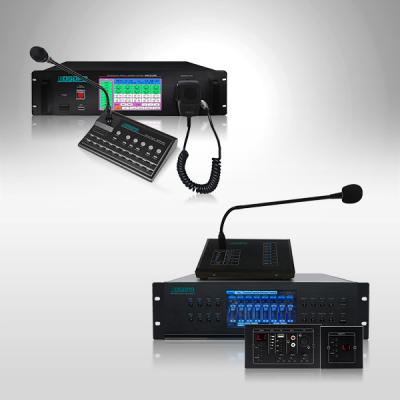

Leave a message



The network-controlled wireless public address system is developed on the basis of "Internet +" technology. It transmits control commands and audio signals through a local area network or wide area network, and forms a broadcasting system with the network-controlled wireless public address system terminals and transmitters. In the past, there was a problem that the distance between the management software and the transmitter was very close (within 5 meters), and the problem that one set of control software could not manage multiple transmitters (multiple wireless broadcasting systems).

1. The wireless public address system supports operation in a wide area network or a local area network environment, and realizes the control of the wireless data broadcasting system's timing, fixed point and zone, and point-to-point arbitrary zone grouping;
2. The maximum number of controllable terminals reaches 1,000;
3. Support real-time voice broadcast, instant play and task play at the same time;
4. Support playing different tasks to different terminals at the same time;
5. The use of aac audio format for data transmission can effectively reduce bandwidth;
6. It can manage each wireless receiving point;
7. You can view the online status of the terminal and transmitter in real time;
8. You can send text to the receiver, modify the receiver frequency, and modify the volume.


This management software has the functions of timing tasks, real-time playback, text transmission, terminal management, cloud server connection, basic settings, and voice real-time broadcast for the transmitter and wireless receiver under the control of the network control terminal, which can easily realize the effective point-to-point management of the transmitters and wireless receivers under the control of the remote network control terminal without geographical restrictions, breaking through the single transmission mode under the restriction of the geographical environment of wireless broadcasting. It plays an important role in the centralized control of large-scale wireless public address systems such as villages, hundreds of counties, tourist attractions, universities, and headquarters management.



 【DSPPA Demo】PAVA8000 EN54 Voice Evacuation SystemNovember 12, 2020Abstract: DSPPA PAVA8000 EN54 Voice Evacuation SystemToday, we are gonna show you a demo about our PAVA8000 EN54 Voice Evacuation System.PAVA8000EN54 Voice Evacuation System can not only support manua...view
【DSPPA Demo】PAVA8000 EN54 Voice Evacuation SystemNovember 12, 2020Abstract: DSPPA PAVA8000 EN54 Voice Evacuation SystemToday, we are gonna show you a demo about our PAVA8000 EN54 Voice Evacuation System.PAVA8000EN54 Voice Evacuation System can not only support manua...view The National Standard Approval Meeting held in BeijingJuly 19, 2019The National Standard Approval Meeting held in BeijingThe approval meeting of the National StandardTechnical standard of public address system engineeringis held in Beijing on July 16, 2019. Xue Chang...view
The National Standard Approval Meeting held in BeijingJuly 19, 2019The National Standard Approval Meeting held in BeijingThe approval meeting of the National StandardTechnical standard of public address system engineeringis held in Beijing on July 16, 2019. Xue Chang...view


